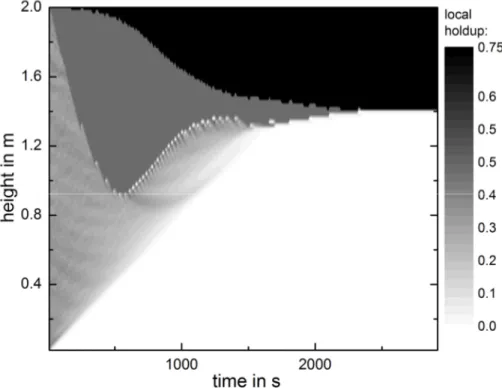Challenges for scale-up of batch phase separations
Prof. Dr.-Ing. Andreas Pfennig, Department of Chemical Engineering, Université de Liège; Karsten Becker, Sven Bach, Werner Bäcker, Murat Kalem, Bayer Technology Services GmbH, Leverkusen; Arndt Reinecke, Sebastian Ruckes, Bayer
CropScience AG, Dormagen
Bi-phasic phase separations in batch processes often are operations which influence cycle times and production capacity. A realistic assessment of phase separation time for technical scale is important with respect to defining vessel sizes, process step-time planning and an optimized adaption to further process steps. This requires a rating of batch mixing & phase-separation at an early step of chemical-process de-velopment in laboratory and a robust scale-up to the technical scale.
Currently available methods for design and optimization of such batch phase-separations show gaps in knowledge and in transfer from laboratory to technical scale. Up to now it is not possible to trustfully predict mean drop diameter or drop-size distribution for technical relevant bi-phasic systems in technical scale based on laboratory tests. These are one of the key inputs to describe phase separation beha-vior, i.e. sedimentation and coalescence. The prediction of drop-size distribution after scale-up is important, since a remaining turbidity is significantly influenced by these. In addition systems with higher viscosity show wider drop-size distributions and ten-dency of turbidity will increase.
The specific industrial demand for a safe and validated scale-up method will be dis-cussed. Aspects are an integral general scale-up method for batch mixing and phase separation, starting with standardized characterization of mixing and phase-separation behavior in lab and development of a scale-up method in order to evalua-te relevant aspects as equipment and mixing device, energy input, mixing time, pha-se pha-separation time, height of dispersion etc.
For modelling the performance of a batch settling accounting for polydisperse drop-size spectra, the model of Henschke has been chosen as starting point, which ac-counts for different average drop sizes. The Henschke model has been extended as to include the sedimentation of drops with polydisperse drop-size distribution accord-ing to the ReDrop approach (representative drops) by modellaccord-ing an ensemble of indi-vidual drops as they sediment and reach the close-packed layer. In principle coale-scence of the sedimenting droplets could be accounted for in this approach, but this has been neglected in this first step.
The Henschke model already accounts for the time- and height-dependent average drop sizes in the close-packed layer. This has been extended as to allow taking the different drop sizes into account of those drops that are arriving at the close-packed layer over time. The coalescence in the close-packed layer is described with the ap-proach used already by Henschke, which has been validated in principle by Kopriwa. The results show that the polydispersity can well be described by this approach (see Fig. 1). Especially – as is to be expected – the major phase separation occurs rela-tively quickly leaving behind fine droplets in the continuous phase. Since this remai-ning turbidity has a relatively low holdup, the sedimentation of the fine dispersion oc-curs essentially with the sedimentation velocity of droplets in infinitely extended me-dium. As a consequence the remaining turbidity as function of settling time can be estimated with relatively good accuracy from the fraction of the fine droplets in the original dispersion and their individual sedimentation velocity. It can also be seen that the close-packed layer disappears after a certain settling time and after that the rate of the arriving droplets is smaller than the time for their coalescence.
The open questions remaining will finally be addressed, namely the prediction of the drop-size distribution after the mixing step, the detailed drop behavior within the close packed layer as well as the influence of large-scale fluid dynamics within the settler.
